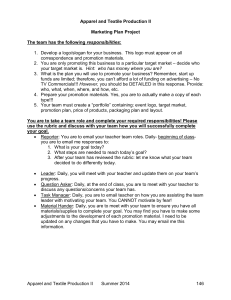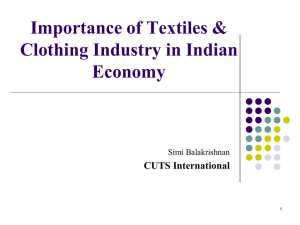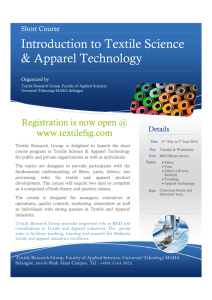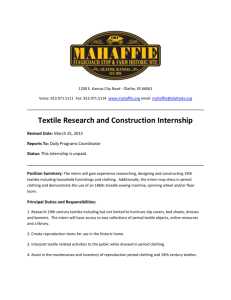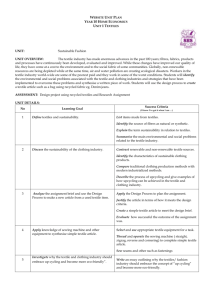china's wto accession - Thunder Lake Management Inc.
advertisement
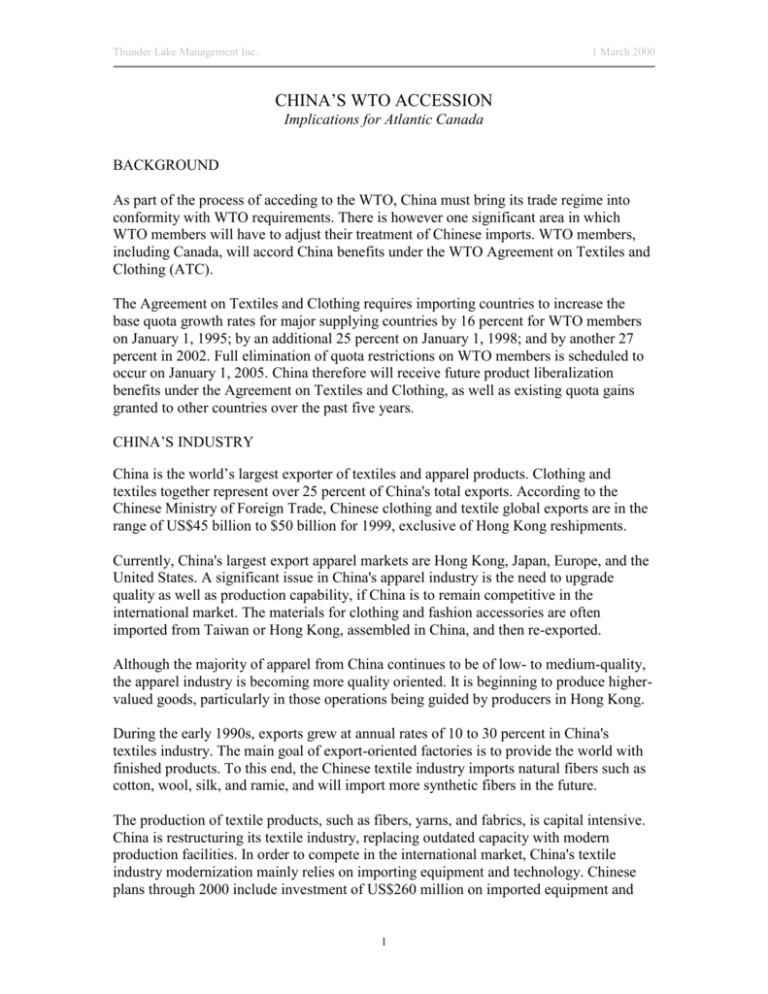
Thunder Lake Management Inc. 1 March 2000 CHINA’S WTO ACCESSION Implications for Atlantic Canada BACKGROUND As part of the process of acceding to the WTO, China must bring its trade regime into conformity with WTO requirements. There is however one significant area in which WTO members will have to adjust their treatment of Chinese imports. WTO members, including Canada, will accord China benefits under the WTO Agreement on Textiles and Clothing (ATC). The Agreement on Textiles and Clothing requires importing countries to increase the base quota growth rates for major supplying countries by 16 percent for WTO members on January 1, 1995; by an additional 25 percent on January 1, 1998; and by another 27 percent in 2002. Full elimination of quota restrictions on WTO members is scheduled to occur on January 1, 2005. China therefore will receive future product liberalization benefits under the Agreement on Textiles and Clothing, as well as existing quota gains granted to other countries over the past five years. CHINA’S INDUSTRY China is the world’s largest exporter of textiles and apparel products. Clothing and textiles together represent over 25 percent of China's total exports. According to the Chinese Ministry of Foreign Trade, Chinese clothing and textile global exports are in the range of US$45 billion to $50 billion for 1999, exclusive of Hong Kong reshipments. Currently, China's largest export apparel markets are Hong Kong, Japan, Europe, and the United States. A significant issue in China's apparel industry is the need to upgrade quality as well as production capability, if China is to remain competitive in the international market. The materials for clothing and fashion accessories are often imported from Taiwan or Hong Kong, assembled in China, and then re-exported. Although the majority of apparel from China continues to be of low- to medium-quality, the apparel industry is becoming more quality oriented. It is beginning to produce highervalued goods, particularly in those operations being guided by producers in Hong Kong. During the early 1990s, exports grew at annual rates of 10 to 30 percent in China's textiles industry. The main goal of export-oriented factories is to provide the world with finished products. To this end, the Chinese textile industry imports natural fibers such as cotton, wool, silk, and ramie, and will import more synthetic fibers in the future. The production of textile products, such as fibers, yarns, and fabrics, is capital intensive. China is restructuring its textile industry, replacing outdated capacity with modern production facilities. In order to compete in the international market, China's textile industry modernization mainly relies on importing equipment and technology. Chinese plans through 2000 include investment of US$260 million on imported equipment and 1 Thunder Lake Management Inc. 1 March 2000 technology, $420 million on plant and infrastructure construction, and $460 million on domestic equipment. Major import groups include equipment for cotton spinning, weaving, dyeing, and finishing, as well as for wool processing and garment production. China has been promoting foreign investment in selected textile industries since the mid1990s. According to a State Planning Commission decree issued in June 1995, the major groups targeted for foreign investment are: 1. Chemical fibers with properties such as being ultra-thin, electrostatic-resistant, fireretarding and high emulation; special chemical fibers such as aryl, spandex and carbon fiber; 2. Textile dyeing and after-treatment; 3. Highly simulated chemical fiber and fabrics; 4. Oils used in textile industries; 5. Special industrial textile products. However, this is likely to be a gradual process, given the political problem of labour rebalancing implied by technological upgrading in China. For the immediate future, the Chinese advantage is in large part based on intensive labour utilization (see graph below, from Economist, November 21, 1992). The potential for growth is greater in China’s apparel industry because apparel production is highly labor-intensive and China has an abundance of skilled, low-cost labor. In comparison to developed and developing countries, China’s textile industry wage rates are among the lowest in the world. Wages in the clothing and apparel industry are broadly comparable. US – CHINA TEXTILE AND CLOTHING TRADE In 1996, China exported about US$6.5 billion of textile and apparel to the United States, compared to US$6 million that the United States sold to China. About three-fourths of US sector imports from China consist of apparel, almost all of which is under quota. According to a newly declassified report by the U.S. International Trade Commission (USITC) on the US economic impact of China’s accession to the WTO, China's share of the U.S. textile market will increase to about 11 percent by 2010 and its share of the apparel market by 18 percent if quotas are removed by Dec. 31, 2004. This result represents a 30% share of the US apparel import market. According to the report, China's entry into the WTO will increase the US bilateral trade deficit because the volume of Chinese imports to the U.S. will increase more than U.S. exports to China. Chinese tariff reductions could increase U.S. exports by as much 10 percent but Chinese imports to the U.S. would go up by 7 percent as a result of increased competitiveness. 2 Thunder Lake Management Inc. 1 March 2000 US DIRECT IMPACTS The USITC notes that certain unspecified data limitations prevented the Commission from providing estimates of changes in U.S. textile and apparel production, employment, imports, and exports. However, economic simulation results suggest that inclusion of China in the ATC quota phase-out will likely have a comparatively smaller impact on U.S. imports of textiles, and a larger effect on U.S. imports of apparel. USITC acknowledges that U.S. textile and apparel industries could be affected, with U.S. apparel producers and workers experiencing the more adverse effects. A study commissioned for the American Textile Manufacturers’ Institute in September 1999 estimates direct textile and apparel job losses at over 95,000 as a result of China joining the ATC. While the labour issues are not exclusively tied to the textile and apparel sector, it is interesting that on February 25, AFL-CIO labor federation President John Sweeney, President Jay Mazur of UNITE! (Union of Needleworkers and Industrial textile Employees), and President Lenore Miller of the Retail, Wholesale and Department Store Union resigned from the President’s Advisory Committee on Trade Policy and Negotiations. Until February 25, the Committee, which is expected to endorse the China agreement, had included 27 corporate representatives, three from labor unions, and one each for environmental and consumer causes. From a political perspective, the textile issue is likely to be a factor in the November election. The winning candidate must secure 270 of 538 Electoral College votes. The major textile and apparel states – California, Georgia, New York, North Carolina, and Pennsylvania – account for 137 votes. In 1996, the Democratic Party took California, New York, and Pennsylvania for 110 votes. SAFEGUARDS Because the accelerated quota growth rates granted China for many of the U.S. textile and apparel quota categories are low and the quotas are likely to constrain trade, USITC forecasts the adverse effects are likely to be experienced after the end of the ATC phaseout period (i.e., after December 31, 2004). Quotas will remain in place until the end of 2004, when the ATC expires. It is perhaps for this reason that the US insisted on a four-year safeguard mechanism through December 31, 2008 for textiles and apparel. However, the precise details of its operational requirements (ie, trigger points) are not available. USTR information indicates that the provision permits US companies and workers to respond to increased imports of Chinese textile and apparel products when they constitute a “market disruption.” The provision allows the imposition of quotas if market disruption or the threat of market disruption occurs. It covers all textile and apparel products under the ATC as at January 1, 1995. Restraints on market disrupting imports become effective upon receipt of a request for consultations. Restraints may remain in place for up to a 3 Thunder Lake Management Inc. 1 March 2000 year, and can be reapplied subsequently. China has no rights to retaliate against these restraints. The provision is drawn from the 1997 US – China Bilateral Textile Agreement. In addition, China agreed to a product specific safeguard to address rapidly increasing imports from China that cause or threaten to cause market disruption on a product specific basis. USTR gives the impression this safeguard also applies to textile and clothing imports from China. This provision remains in effect for 12 years after accession. After an initial three-year period, China can act against US exports along similar lines. US anti-dumping laws, which will treat China as a non-market economy for the next 15 years, provide a third avenue of defence. It is possible as well that US Customs will address weaknesses in rules of origin regulations and marking requirements for textiles and apparel. This is an area of interest because there are potential issues related to “substantial transformation” involving trade among all three NAFTA partners that could arise as a result of rising Chinese imports. Finally, it is unclear whether these provisions will apply to textiles and clothing originating in the Hong Kong SAR, which is a major source of textile and clothing imports for Canada and the US. This discussion does not take account of imports from Hong Kong. At this point it appears that a proper evaluation of the effectiveness of special textile and apparel safeguards will have to await a publicly available text. This is likely to occur in the US first, as there is mounting pressure to make it public. THIRD COUNTRY IMPACTS Although US industries will be affected, USITC considers it likely that increased Chinese exports will come mainly at the expense of other suppliers to the US market. The USITC summary states, … This increase in China’s share in the U.S. import market would occur as Chinese products would displace exports from other suppliers, particularly suppliers whose exports currently are not restricted by quotas (i.e., the “rest of world” group). [Emphasis added] CANADIAN TRADE PROFILE In Canada’s case, the terms of entry for Chinese apparel and textiles have not been made public. Pending more information, it could be assumed that the Canada-China deal corresponds in key respects to the US-China deal. In other words, it does not contain terms more favourable than the US provisions. However, this is no assurance that the terms are not less favourable. The trade data show the scale of Chinese dominance in bilateral trade with Canada. Whereas Canadian exports over the last four years grew by less than 3% annually, 4 Thunder Lake Management Inc. 1 March 2000 Chinese exports averaged almost 14%. In the absence of quota restraints, it appears likely that Canada’s sectoral deficit will increase in the future. CANADA – CHINA TEXTILE AND CLOTHING TRADE 1994 1995 1996 1997 1998 Exports 109,270,000 149,613,000 114,216,000 324,343,000 234,843,000 to China Imports 1,027,000,000 1,189,000,000 1,086,000,000 1,389,000,000 1,598,000,000 from China Source: Statistics Canada. SIC 1800, 1900, and 2400. This table includes sub sectors of SIC 1800, accounting for the difference in tabular presentations. CANADIAN IMPORTS BY INDUSTRY 1994 1995 Clothing 606,000,000 670,000,000 Primary 95,921,000 119,245,000 Textiles Textile 113,939,000 161,410,000 Products 1996 1997 1998 662,000,000 876,000,000 1,008,000,000 96,556,000 123,489,000 144,790,000 134,299,000 143,016,000 156,080,000 Source: Statistics Canada. SIC 1800, 1900, and 2400 Like the US import profile, more than 75% of Canada’s sector imports from China are apparel products, most of which are subject to quotas. Despite quotas on apparel, Canada received shipments valued at over $1 billion in 1998. The elimination of access limits for both textiles and apparel could have an effect similar to that expected in the US. It is therefore of considerable interest to determine what special safeguard mechanisms have been built into the Canada – China protocol agreement to address import surges, and potential market disruption for the Canadian textile and clothing industries. Clearly, there are also implications for Canadian textile and clothing sales to the US market as a result of the Chinese accession. Both the US industry and the government recognize that to be the case. Though the impact is smaller for textiles than apparel, all foreign exporters to the US lose share to China. The US industry estimates that by 2005 Canada and Mexico will export US$1.9 billion or about CD$2.8 billion less in textile and apparel to the US market. This represents an overall 14% reduction in sales to the US market. Canada’s share, based on 1998 US imports, is about $1.2 billion. 5 Thunder Lake Management Inc. 1 March 2000 US IMPORTS FROM NAFTA PARTNERS TEXTILES AND CLOTHING 1998 Exports Mexico $11.6 billion Share 58.6% 2005 Reduction $1.6 billion Canada 41.4% $1.2 billion $8.2 billion Thus, the general impact for Canada of increased Chinese market access in North America is: 1. An erosion of US markets for Canadian textiles and clothing, with potential for competitive pressures to accelerate after 2005; 2. Increased pressure on Canadian apparel manufacturers in the domestic market, particularly from higher quality Chinese products; and 3. Long term competitive pressures as China modernizes and expands its textile and apparel production capacity, and makes its way up the quality ladder. ATLANTIC CANADA TRADE IN TEXTILES AND CLOTHING Compared to other industries, the bilateral trade in textiles and clothing with the US is small even by regional trade standards. However, it would be a mistake to consider SMEs in these sectors as unimportant to the region’s employment and future economic prosperity. Moreover, the issue is not simply about export challenges in the US market; it is also about competing against potential displacement by Chinese products on home turf. The US is the key non-domestic market for the region’s textile and clothing firms. Almost 95% of the region’s exports from the clothing, primary textiles, and textile products industries are shipped to the US. ATLANTIC CANADA – US TEXTILE AND CLOTHING TRADE* Imports from US Exports to US 1994 1995 1996 66,724,853 64,011,108 60,773,297 1997 64,237,132 1998 70,299,610 23,359,165 27,702,905 40,832,174 48,825,061 50,717,444 Bilateral 90,084,018 91,714,013 101,605,471 113,062,193 121,017,054 Total *SIC 2400, 1800, and 1900 (Clothing, Primary Textile, and Textile Products Industries, respectively) 6 Thunder Lake Management Inc. 1 March 2000 These industries have enjoyed growth rates for exports to the US market of more than 25% annually over the last four years. This has pushed Atlantic exports from 26% as a proportion of bilateral sector trade to more than 40%. Because Atlantic Canada’s share of total Canadian sector exports to the US is 0.62%, we could expect the regional share of the reduction to be $7.4 million. While not a huge number, in the context of regional exports valued at $50.7 million, this represents a decline in export sales of 14.5%. This does not take into account any adverse affect arising from Chinese competition in the domestic market. Nor does it account for other related light manufactures such as footwear and leather goods, which USITC also identifies as likely to be adversely affected by the Chinese accession. Unpacking the export data, the most important export segment, based on shipment ATLANTIC CANADA – US TEXTILE PRODUCTS TRADE Imports from US Exports to US 1994 1995 1996 1997 1998 38,887,760 35,031,431 33,537,639 39,004,837 42,002,420 13,991,377 18,302,765 26,518,216 27,328,519 30,415,731 Bilateral 52,879,137 53,334,196 60,055,855 66,333,356 72,418,151 Total Source: Statistics Canada. Carpets, rugs, canvas products including sails, covers, tents, trims and ribbons. values, is the textile products sector. Over the last five years, over 90% of exports from the textile products industry in Atlantic Canada has been shipped to the US. Reflecting their dominance in the cumulative figures, textile products exports have averaged over 29% growth annually in the last four years. The strong US new home construction and renovation markets are a key factor in this performance, aided by the persistent foreign exchange differential. A key issue will be ensuring that this market development success is not unduly curbed by the imminent entry of Chinese product. It is noteworthy that China has been among the top textile exporters to Atlantic Canada over the 1994 – 1998 period. Annual shipments thus far, however, have averaged under $1 million. Bilateral trade in primary textiles has grown on average more than 10% annually. Exports, however, have expanded rapidly, increasing about 40% annually in the last four years. In 1998, over 90% of regional exports were shipped to the US. 7 Thunder Lake Management Inc. 1 March 2000 ATLANTIC CANADA – US PRIMARY TEXTILE TRADE Imports from US Exports to US 1994 1995 1996 1997 1998 23,619,237 26,228,778 24,555,946 22,318,342 26,318,927 6,104,959 7,468,168 11,454,130 18,362,555 15,797,088 Bilateral 29,724,196 33,696,946 36,010,076 40,680,897 42,116,015 Total Source: Statistics Canada. Knitted fabrics, spun yarn, man-made fibres. Imports grew less than 3% annually in the same period. As an input to the further manufacturing process, this industry is also a potential casualty of Chinese accession. It is evident that the apparel trade is the least developed, and perhaps the most exposed segment. While 79% of product goes to the US market, it is this segment of the industry that faces the most severe test. ATLANTIC CANADA – US APPAREL TRADE Imports from US Exports to US 1994 1995 1996 1997 1998 3,238,000 2,298,000 2,405,000 2,563,000 1,623,000 3,110,000 1,736,000 2,644,000 2,781,000 4,093,000 Bilateral 6,348,000 4,034,000 5,049,000 5,344,000 5,716,000 Total Source: Statistics Canada. Given the modest exports from the region, it is possible that Chinese products in a very brief time span could displace them. Atlantic apparel exports – including a wide range of garments and clothing, men’s, women’s and children’s wear, shirts, underwear, and so on – are at risk. STRATEGIC CONSIDERATIONS During the 1990s, segments of the Canadian textile and clothing industry increased spending on technology applications, and became more export intensive. The textile products industry, for example, has become more export oriented. Exports as a proportion of total Canadian shipments increased from 9.2% in 1991 to 30.5% in 1998. The primary textiles sector saw its ratio of exports to shipments rise from 24.9% to 52.3% in the same period. There are therefore some fundamental strengths at work in these industries at large. 8 Thunder Lake Management Inc. 1 March 2000 Though the textile and clothing industries nationally have been incorporating technology in the production process, and investing in technology at rates higher than the average for the manufacturing sector as a whole, there are areas that remain weak. According to a study published in 1996 by HRDC, the Canadian textile industry has a concentration of middle-aged persons with 55% of the labour force between 35 and 44 years of age. Among those employed as production workers, 40% have no high school diploma. Clearly, any prospective job losses would have a profound affect on these individuals. The HRDC study also noted that the textile industry often represents a key, and occasionally the sole source of employment and economic activity in small communities. As a result the study identified, among other things, the need for management training related to export markets and competitive behaviour. CONCLUSION Though the threat is not immediate, enough is known of future developments to warrant a closer examination of the issue, and to ensure that the sector continues to contribute to economic development in Atlantic Canada. A closer examination could identify specific regional industry competitive advantages that may help to mitigate the ultimate challenge of quota free Chinese entry to the US and the Canadian markets. In other words, a more complete SWOT analysis can be used to develop a specific industry level plan for addressing the challenges likely to emerge in the next few years in Atlantic Canada. More generally, industries in which China has world export leadership or significant growth potential, should be examined more closely. Atlantic Canada exports to the US in competitively vulnerable industries – textiles and clothing, leather goods, footwear, toys and electronic equipment – were worth more than $135 million in 1998. 9
